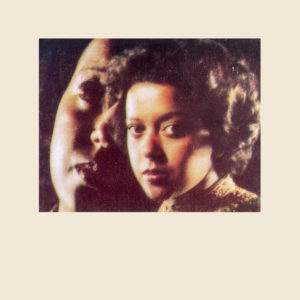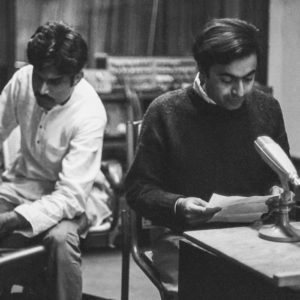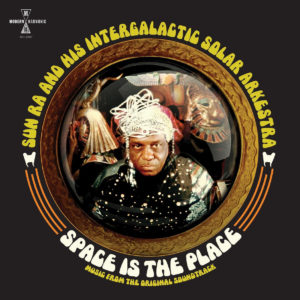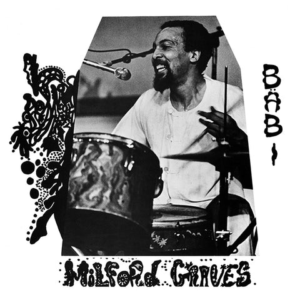Kuku Sebsibe – Kuku Sebsibe (Little Axe)
 Absolutely dazzling 1982 solo debut by the young Ethiopian singer, backed by the legendary Roha Band. After stints with Alemayheu Eshete, and Hailu Mergia’s Walias, Sebsibe strides on her own, striking the perfect balance of innocent wonder and youthful melancholy. All the touchstones of timeless Ethio-R&B in full swing – circular rhythms, dusky keyboards, deep-pocket horns, all elevating Sebsibe’s celestial, graceful voice. Never a dull moment, enchanted in every turn, layers keep revealing themselves with repeated listens. Released to very little fanfare by Little Axe, this is one of those sleeper stunners that, once awakened, stays in heavy rotation. Unmissable.
Absolutely dazzling 1982 solo debut by the young Ethiopian singer, backed by the legendary Roha Band. After stints with Alemayheu Eshete, and Hailu Mergia’s Walias, Sebsibe strides on her own, striking the perfect balance of innocent wonder and youthful melancholy. All the touchstones of timeless Ethio-R&B in full swing – circular rhythms, dusky keyboards, deep-pocket horns, all elevating Sebsibe’s celestial, graceful voice. Never a dull moment, enchanted in every turn, layers keep revealing themselves with repeated listens. Released to very little fanfare by Little Axe, this is one of those sleeper stunners that, once awakened, stays in heavy rotation. Unmissable.
Aselefech Ashine & Getenesh Kebret – ሸገኔዎች (Beauties) (Mississippi Records)
Emahoy Tsege Mariam Gebru – Jerusalem (Mississippi Records)
 Mississippi Records is hands-down one of the finest archival labels in the world, so no surprise they’d feature several times on any reissue roundup. Beauties, released almost simultaneously with Little Axe’s Sebsibe joint, (Mississippi is Little Axe’s parent label,) is another crown jewel of Golden Era Ethiopian jazz. Almost impossible to discern which voice belongs to whom, Ashine and Kebret’s unison vocals often sound as if emanating from one magical individual. Minor key laments mix with heartwarming ballads, with a couple rocksteady-ish stompers for good measure, music like this could only be made in a certain time and place.
Mississippi Records is hands-down one of the finest archival labels in the world, so no surprise they’d feature several times on any reissue roundup. Beauties, released almost simultaneously with Little Axe’s Sebsibe joint, (Mississippi is Little Axe’s parent label,) is another crown jewel of Golden Era Ethiopian jazz. Almost impossible to discern which voice belongs to whom, Ashine and Kebret’s unison vocals often sound as if emanating from one magical individual. Minor key laments mix with heartwarming ballads, with a couple rocksteady-ish stompers for good measure, music like this could only be made in a certain time and place.
 Speaking of time capsules, Mississippi uncovers yet another treasure trove from Emahoy Tsege-Mariam Gebru, an Ethiopian nun who sadly passed away in March of 2023 at age 99, just a few weeks ahead of Jerusalem’s release. During the second Italo-Ethiopian war, she and her family were captured and sent to POW camps in Italy (c 1935-37); after the conflict she studied Western classical music in Cairo, eventually returning to Ethiopia in the early 40s, settling in a hilltop monastery. After a decade of “no shoes, no music, just prayer,” she helped found orphanages around Addis Abbaba, amid more political conflict, often composing and recording music privately in her spare time. These recordings, meditations for piano and voice, date to the early 1970s, before her relocation to Jerusalem in the 80s. When it comes to non-Western “outsider art,” perhaps no one is as singular, as dedicated, and revered as Gebru.
Speaking of time capsules, Mississippi uncovers yet another treasure trove from Emahoy Tsege-Mariam Gebru, an Ethiopian nun who sadly passed away in March of 2023 at age 99, just a few weeks ahead of Jerusalem’s release. During the second Italo-Ethiopian war, she and her family were captured and sent to POW camps in Italy (c 1935-37); after the conflict she studied Western classical music in Cairo, eventually returning to Ethiopia in the early 40s, settling in a hilltop monastery. After a decade of “no shoes, no music, just prayer,” she helped found orphanages around Addis Abbaba, amid more political conflict, often composing and recording music privately in her spare time. These recordings, meditations for piano and voice, date to the early 1970s, before her relocation to Jerusalem in the 80s. When it comes to non-Western “outsider art,” perhaps no one is as singular, as dedicated, and revered as Gebru.
Tolerance – Divin / Anonym (Mesh-Key Records)

Junko Tange was a Japanese nursing student who released two mind-bending albums for Osaka’s Vanity records in 1980/81, then promptly vanished from music. The Vanity Archive Project released their entire catalog on CD several years ago, of which these were instant standouts, but 2023 saw their first reissue on vinyl. Insanely deep bedroom sound design for its time, both records beguile in mystery and sonic subtexts. Whereas Anonym, the first of the pair, relies on sparse guitars, barely-there voice, and free-floating synth rhythms, Divin goes deep on sub-bass and dub echo around half-built song-structure/scaffolding. Imagine someone living out a fantasy of being in the band Chrome, but inundated by medical study and too timid to leave the house, and you’re almost halfway to Tolerance.
The NID Tapes: Electronic Music from India 1969-1972 (the State51 Conspiracy)

Forget all those cliches of “psychedelic” sitars and tabla shenanigans, hippies co-opting Gandhi/pacifism like a fashion statement, in late 60s Western pop culture (as if MLK hadn’t walked a similar path a decade before.) The music recorded by architects, poets, and other curious individuals at India’s National Institute of Design in Ahmedabad, is the real deal. Established by American composer David Toop in 1969, these reels contain some of the first forays into electronic composition on the subcontinent, but subsequently stored and forgotten until a happenstance discovery in 2022 led to a formal revival, remaster, and first-ever release in 2023. Tape loops of field recordings mutate alongside modular Moog mischief, elements of Indian classical music inform sonic sci-fi soliloquies, this is the sound of pure exploration and experimentation, democratized and available to anyone. Radical, indeed.
Charles M. Bogert – Sounds of North American Frogs (Smithsonian Folkways)
 How can you not love a record like this? Charles Bogert spent the entirety of his 1957 Guggenheim Fellowship traveling around the US and northern Mexico recording sounds emanating from ditches, ponds, bogs, and anywhere else he found an amphibious friend. One of the US’s premier herpetologists (frog expert) at the time, Bogert narrates each audio entry of over 90 species with the prestige of knowledge without ego combined with the love of a hobbyist gone pro. Giving environmental context along with biological idiosyncrasy, as well as an uncommon dexterity with Latin-genus pronunciation, there’s nothing that isn’t charming about this document. Folkways presented this first-ever reissue as part of its 75th anniversary celebration in 2023, and the world is a hoppier place for it.
How can you not love a record like this? Charles Bogert spent the entirety of his 1957 Guggenheim Fellowship traveling around the US and northern Mexico recording sounds emanating from ditches, ponds, bogs, and anywhere else he found an amphibious friend. One of the US’s premier herpetologists (frog expert) at the time, Bogert narrates each audio entry of over 90 species with the prestige of knowledge without ego combined with the love of a hobbyist gone pro. Giving environmental context along with biological idiosyncrasy, as well as an uncommon dexterity with Latin-genus pronunciation, there’s nothing that isn’t charming about this document. Folkways presented this first-ever reissue as part of its 75th anniversary celebration in 2023, and the world is a hoppier place for it.
Sun Ra & His Intergalactic Solar Arkestra – Space is the Place (Music from the Original Soundtrack) (Modern Harmonic)
 In 1972, the Arkestra hauled themselves to Oakland and stayed with members of the Black Panther Party to film Ra’s sci-fi fable, “Space is the Place.” (Fun fact: they used the same soundstage during the day which, at night, was used to film future-cult-classic X-rated game-changer “Behind the Green Door.”) The music for the soundtrack never really went out of orbit, but other recordings made during the same period are released in this deluxe box for the first time in 2023. Whereas most tracks of the classic soundtrack are Ra staples, condensed yet still spaced-out, bathed in reverb, the bonus LP of unearthed tracks hold extended sound abstractions and tone poems. Ra sounds as if on a pulpit’s pedestal, preaching about outer mathematics and rhythmic equations, chastising humanity for its transgressions yet welcoming its transcendence to the Greater Universe. A must for completeness, and still one of the best primers for the curious, the 3xLP set pinpoints newly-discovered stars in Sun Ra’s still-expanding galaxies.
In 1972, the Arkestra hauled themselves to Oakland and stayed with members of the Black Panther Party to film Ra’s sci-fi fable, “Space is the Place.” (Fun fact: they used the same soundstage during the day which, at night, was used to film future-cult-classic X-rated game-changer “Behind the Green Door.”) The music for the soundtrack never really went out of orbit, but other recordings made during the same period are released in this deluxe box for the first time in 2023. Whereas most tracks of the classic soundtrack are Ra staples, condensed yet still spaced-out, bathed in reverb, the bonus LP of unearthed tracks hold extended sound abstractions and tone poems. Ra sounds as if on a pulpit’s pedestal, preaching about outer mathematics and rhythmic equations, chastising humanity for its transgressions yet welcoming its transcendence to the Greater Universe. A must for completeness, and still one of the best primers for the curious, the 3xLP set pinpoints newly-discovered stars in Sun Ra’s still-expanding galaxies.
Milford Graves – Bäbi (Superior Viaduct)
Sonny Sharrock – Black Woman (Superior Viaduct)

When Superior Viaduct goes deep, they go deeeeep. In 2023, among around a dozen titles given deluxe treatment, two stone-cold classics of 70s Fire music made it back to rotation, both featuring the legendary, inimitable Milford Graves on percussion. Already a notorious presence by the time Graves formed the Bäbi trio with Arthur Doyle and Hugh Glover (both on reeds,) this set from 1976 set a new benchmark for unparalleled, unhinged and unpredictable improvisation. Graves custom-built his kit (no snare, all toms, no bottom heads) to better control tone and dynamics, and explodes right out of the gate. Wordless vocalizing from the whole trio whirl in and out, and around, at any given moment. Doyle and Glover’s reeds match Grave’s shamanic intensity with fierce runs and howls, changing directions on a dime. Lightning in a bottle, a masterclass in otherworldly humanism.
 No album merges the intersections of late 60s Soul Jazz and the forefront of Black Avant-Garde like Sonny Sharrock’s “Black Woman,” yet it’s often overlooked in conversations about either of those movements. Perhaps the world wasn’t, and largely still isn’t, prepared for Sharrock’s shredded guitar skronk (though few hesitate to laud his later White counterparts,) or the vocal turns of his then-partner Linda (maligned/praised for a similar “style” to Yoko Ono – yet more accurately, Abbey Lincoln.) Its undeniable groove, an homage/furthering of funk rock and R&B, sets forth a deconstruction and reconfiguring of preconceived ideas of any genre. It’s a protest album that whirls like a dervish, rallies for the liberation of music itself, against the confines of commercialism, using the tools of the masses to lead them toward pure, individual expression. Sly Stone got nothing on this.
No album merges the intersections of late 60s Soul Jazz and the forefront of Black Avant-Garde like Sonny Sharrock’s “Black Woman,” yet it’s often overlooked in conversations about either of those movements. Perhaps the world wasn’t, and largely still isn’t, prepared for Sharrock’s shredded guitar skronk (though few hesitate to laud his later White counterparts,) or the vocal turns of his then-partner Linda (maligned/praised for a similar “style” to Yoko Ono – yet more accurately, Abbey Lincoln.) Its undeniable groove, an homage/furthering of funk rock and R&B, sets forth a deconstruction and reconfiguring of preconceived ideas of any genre. It’s a protest album that whirls like a dervish, rallies for the liberation of music itself, against the confines of commercialism, using the tools of the masses to lead them toward pure, individual expression. Sly Stone got nothing on this.
Nina Simone – You’ve Got to Learn (Live) (Verve)
 Anything “new” from Nina Simone is always cause for celebration. Her performance at Newport Jazz in 1966 was one of those mythical moments folks talk about for years. Or in this case, generations. Thanks to the archival work of venerable Verve records, recently discovered tapes allow us all into Nina’s timeless audience. From the fragile yet strong-willed title-track opener, through rearranged standards simultaneously melancholy and hopeful, Nina’s dedication to the blues and the not-so-abstract truth reverberates as vital and prescient today as it was then. Legend has it, the crowd applauded so rapturously the next act was refused access to the stage. So what does Nina do? Perform an encore of “Mississippi, Goddamn” so incendiary, so poignant it smokes the “standard” live version she performed at Carnegie Hall two years prior to embers. For anyone remotely skeptical of Ms Simone’s power to convey every emotion possible, THIS will make you a believer.
Anything “new” from Nina Simone is always cause for celebration. Her performance at Newport Jazz in 1966 was one of those mythical moments folks talk about for years. Or in this case, generations. Thanks to the archival work of venerable Verve records, recently discovered tapes allow us all into Nina’s timeless audience. From the fragile yet strong-willed title-track opener, through rearranged standards simultaneously melancholy and hopeful, Nina’s dedication to the blues and the not-so-abstract truth reverberates as vital and prescient today as it was then. Legend has it, the crowd applauded so rapturously the next act was refused access to the stage. So what does Nina do? Perform an encore of “Mississippi, Goddamn” so incendiary, so poignant it smokes the “standard” live version she performed at Carnegie Hall two years prior to embers. For anyone remotely skeptical of Ms Simone’s power to convey every emotion possible, THIS will make you a believer.
More Posts for Show: By All Means Necessary